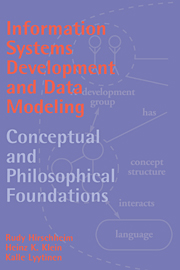Book contents
- Frontmatter
- Contents
- Preface
- Acknowledgements
- 1 Introduction
- 2 Definition and Evolution of Information Systems Development Methodologies and Data Modeling
- 3 Philosophical Foundations
- 4 Conceptual and Paradigmatic Foundations of ISD
- 5 Paradigmatic Analysis of ISD Methodologies
- 6 Conceptual and Paradigmatic Foundations of Data Modeling
- 7 Paradigmatic Analysis of Data Modeling Approaches
- 8 Conclusions
- Appendix A Summaries of Selected Methodologies
- Bibliography
- Index
Appendix A - Summaries of Selected Methodologies
Published online by Cambridge University Press: 05 November 2011
- Frontmatter
- Contents
- Preface
- Acknowledgements
- 1 Introduction
- 2 Definition and Evolution of Information Systems Development Methodologies and Data Modeling
- 3 Philosophical Foundations
- 4 Conceptual and Paradigmatic Foundations of ISD
- 5 Paradigmatic Analysis of ISD Methodologies
- 6 Conceptual and Paradigmatic Foundations of Data Modeling
- 7 Paradigmatic Analysis of Data Modeling Approaches
- 8 Conclusions
- Appendix A Summaries of Selected Methodologies
- Bibliography
- Index
Summary
In these summaries of selected methodologies, it should be noted that in the case of the structured methodologies and prototyping, we are really describing a ‘family of methodologies’ rather than a single approach.
In order to provide a sense of consistency throughout these summaries, the methodology descriptions consist of four parts:
(1) an analysis of the reasons why the particular methodology was proposed (its purpose and rationale);
(2) a concise examination of the key ideas underlying the methodology by which it hopes to achieve its stated purpose (its focus);
(3) a characterization of the methodology's principal stages and their sequence (its phase structure); and
(4) a list of its special methods and tools with their intended purpose.
In order to highlight the special features of each methodology, in some cases we relate these features to the classical system life-cycle (cf. the systems analysis textbooks of Kendall and Kendall 1988; Yourdon 1989).
Structured Methodologies
Purpose and rationale
The most common forms of structured methodologies can be traced to the classic works of Gane and Sarson (1979), DeMarco (1978) and Yourdon (1989). They were introduced to cope with the complexity of analysis and design and problems which the complexity caused with descriptions used in the classical life-cycle approach. The latter lacked a clear focus and organization for the analysis and predefined formats for describing and filing the myriad of details that a development exercise collects during the systems development process beginning with vague descriptions of the problem and ending (hopefully) with detailed program specifications and user documentation.
Information
- Type
- Chapter
- Information
- Information Systems Development and Data ModelingConceptual and Philosophical Foundations, pp. 239 - 251Publisher: Cambridge University PressPrint publication year: 1995
